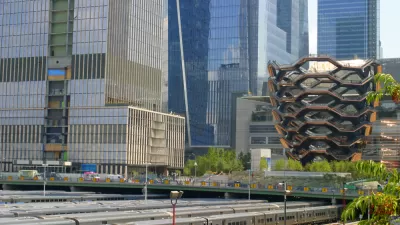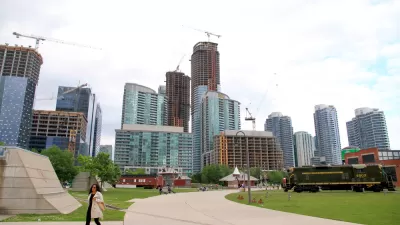A new tool developed in British Columbia calculates the cost of infrastructure over the entire life cycle of the project.

Writing in the Strong Towns Journal, Seairra Sheppard describes a free tool developed by the Province of British Columbia “designed to help local municipalities ‘estimate the lifecycle cost implications of different land use patterns over a 100-year period,’” making it easier to make informed land use and infrastructure decisions.
The community lifecycle infrastructure costing tool (CLIC tool) “can help local governments estimate the entire lifecycle costs of infrastructure, such as water, sewer and transportation, for different land use patterns, for example, compact- versus low-density development.”
According to Sheppard, the tool “has the ability to generate long-term infrastructure cost implications through a comparison analysis.” Several municipalities have already tested it out, including Prince George, which used CLIC to calculate the costs of building a new low-density subdivision compared to a medium-density infill development. The city found that “[i]nitial capital costs in the infill scenario are a mere fraction (about 94–97% lower) than that of the subdivision scenario.” Provincial leaders hope that making CLIC available freely will help cities gather more information about long-range impacts before making major infrastructure investments.
FULL STORY: A New Tool to Calculate the Lifecycle of Infrastructure

Americans May Be Stuck — But Why?
Americans are moving a lot less than they once did, and that is a problem. While Yoni Applebaum, in his highly-publicized article Stuck, gets the reasons badly wrong, it's still important to ask: why are we moving so much less than before?

Using Old Oil and Gas Wells for Green Energy Storage
Penn State researchers have found that repurposing abandoned oil and gas wells for geothermal-assisted compressed-air energy storage can boost efficiency, reduce environmental risks, and support clean energy and job transitions.

Placekeeping: Setting a New Precedent for City Planners
How a preservation-based approach to redevelopment and urban design can prevent displacement and honor legacy communities.

Colorado Lawmakers Move to Protect BRT Funding
In the face of potential federal funding cuts, CDOT leaders reasserted their commitment to planned bus rapid transit projects.

Safe Streets Funding in Jeopardy
The Trump administration is specifically targeting bike infrastructure and other road safety projects in its funding cuts.

Six Reasons Why Housing Is a Human Right
Is housing a human right? A law professor shares six reasons why it should be, from its role in protecting other rights to global recognition and U.S. legal traditions. As public support grows, could housing be the next right written into law?
Urban Design for Planners 1: Software Tools
This six-course series explores essential urban design concepts using open source software and equips planners with the tools they need to participate fully in the urban design process.
Planning for Universal Design
Learn the tools for implementing Universal Design in planning regulations.
Heyer Gruel & Associates PA
City of Moreno Valley
Institute for Housing and Urban Development Studies (IHS)
City of Grandview
Harvard GSD Executive Education
Salt Lake City
NYU Wagner Graduate School of Public Service
City of Cambridge, Maryland





























